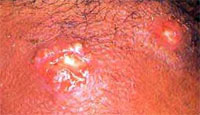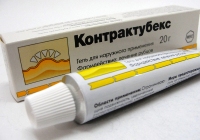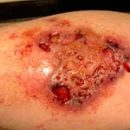Staphylodermia is a purulent skin disease, whose causative agent is a microorganism of the genus Staphylococcus. The main forms of the disease are ostiopholic acid, carbuncoon, furuncul, sicosis and epidemic bubble of newborns.
Content
The concept of stafilodermia
Piedlemia is a group of skin diseases, the main symptom of which is the suppuration. The causative agent of stafilodermia is the bacterium of the kind of streptococcus. The following varieties of stafilodermia are distinguished:
- Ostiopollyculite
- Follyculite
- sycosis
- Epidemic bubble of newborns (surface staphylodermia)
- furuncle
- carbuncle
- Hydragenite (deep stafilodermia)
Ostiopollyculite
 Ostiopollyculite - Located at the mouth of the hair follicle, a small pustula (bubble) with a dense tire, in the center of which is the hair, and along the periphery is a narrow rim of hyperemia (redness).
Ostiopollyculite - Located at the mouth of the hair follicle, a small pustula (bubble) with a dense tire, in the center of which is the hair, and along the periphery is a narrow rim of hyperemia (redness).
When the extension in the depths of the hair follicle, the ostiopholliculite is transformed into folliculitis, which differs from the first presence of infiltrate in the form of an inflammatory nodule, located around the hair. Ostiopholiclyculites and folliculites can be single and multiple. They are localized on any skin of the skin, where there are long or well-developed powder hair. When healing, an purulent crust is formed, after removal, which is detected by a blue-pink spot, with time the disappearing.
Staphylococcal sicosis
Staphylococcal sicosis - multiple, dormantly located on a blue-red and infiltrated skin usually chin and the upper lip of isphoculiculites and follicles located at various stages of development and prone to long-term, sometimes long-term recurring current.
Epidemic bubble of newborns
The epidemic bubble of newborns is an acute disease that affects newborns in the first 7-10 days of life. It is characterized by numerous bubbles of various sizes with a transparent or turbulent content and thin denye tire. All skin cover is affected, with the exception of palms and soles.
Bubbles Party leaning with the formation of thin crusts or, continuing to increase in size, merge with each other and open, leading to the formation of erosive surfaces, sometimes breathtaking skin (exfoliative ritter dermatitis). Perhaps involvement in the process of mucous membranes. Common phenomena can be joined, sometimes heavy, leading to death.
Furuncle
Furunkul is a purulent-necrotic inflammation of the hair follicle and the surrounding fabrics. Furuncul is an isgery node with a bubble on the top. At the opening, the necrotic rod is exposed, on the rejection of which a ulcer is formed, healing by the scar. Manifestation of the disease is pain. Furuncules can be solid and multiple, the flow can be acute and chronic. Sometimes they join lymphadenitis and lymphangitis, fever. When localization on the face, especially in the nasolabial triangle, meningane complications are possible.
Carbuncle
Carbuncoon - a dense deep infiltrate (tissue sealing) of crimson-red color with phenomena of a pronounced edema, resulting from purulent inflammation of the skin and subcutaneous fatty fiber. Through the formed holes highlighted thick pussy, mixed with blood. At retraction of purulent masses, a deep ulcer is formed, healing the rough scar. Manifestation of the disease are painful pain. The general condition is usually violated. Carbuncules arise from weakened and depleted persons on the back of the head, back and lower back. Facial carbuncles are extremely dangerous, such patients are mandatory to be hospitalized into surgical hospital.
Hydradenit
Hydradenitis - purulent inflammation of sweat glands. In the skin (usually armpits) is an isgery node formed, at the autopsy of which the pussy is distinguished. Subsequently the process is subjected to scarring. There is a soreness. Total disorders are possible, especially with multiple hydraenites forming massive conglomerates. Hydranyat is more common in full women suffering from sweating.









